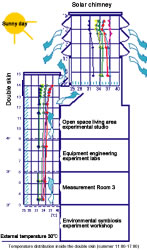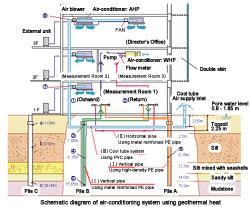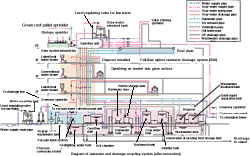The Frontier Center for Environmental Symbiosis Technology, Kanto-Gakuin University
Heat load reduction system by linking the functions of the hanging double skin structure and a solar chimney
 |
|||
| Temperature distribution inside double skin (summer) | |||
 |
 |
||
The double skin on the west side and the solar chimney installed on the rooftop can operate independently or in conjunction with each other. The aim of this is to remove heat load in summer, promote natural ventilation in spring and autumn, and raise the level of thermal insulation in winter, thus enhancing energy-saving effects. We have achieved a heat removal rate of 60% in summer, with an indoor PMV value averaging between 0 and +0.5. By night purge using natural ventilation in the spring and autumn, we have been able to lower the indoor wall temperature by 1.0-1.5°C, and to delay the start time of cooler operation by about an hour. In winter, the internal temperature can reach 30-40°C if the openings in the double skin and solar chimney are closed. This makes it possible to reduce heating load, and the PMV value has also been kept between -0.4 and +0.5. As a result, we have been able to secure a comfortable indoor environment throughout the year while at the same time conserving energy.
Air-conditioning system using geothermal heat via various heat exchange pipes using coastal soil
 |
|||
| Scheme of air-conditioning system using geothermal heat | |||
 |
 |
 |
|
We proposed an air-conditioning system using ground heat from soil of coastal regions, where groundwater levels are high. As the method of heat exchange for this system, we used vertical heat exchange pipes attached to the foundation piles (high-density polyethylene (PE) pipes and metal reinforced PE pipes), together with horizontal heat exchange pipes (metal reinforced PE pipes) and cool tubes (polyvinyl-chloride pipes), and studied their effectiveness. With the vertical heat exchange pipes, we demonstrated that the thermal discharge volume was 1.8 times greater than that using inland soil in summer, and the heat collection volume was 2.5 times greater in winter. The horizontal heat exchange pipes produced effects on a par with vertical heat exchange pipes, with cool tubes producing a performance on the same level as in cold region inland soil.
System for use of rainwater drainage through integration of supply and wastewater renewal technology
 |
|||
| Scheme of rainwater utilization system | |||
 |
 |
 |
|
We planned a rainwater drainage reutilization system which uses the heat storage and elevated water tanks of the existing building, together with newly installed water conservation devices, rooftop greenery (including biotope) systems, and other resource conservation technology. On verifying the water conservation effects, we were able to achieve a high value of about 70% for the water supply substitution ratio. Besides these, we established water quality management technology for gray water used in WC flushing, etc., as well as maintenance technology for water quality improvement and rainwater drainage utilization systems.
Previous Building |
 |
 |
 |
 |
 |
 Next Building Next Building |
CASBEE is a method for rating the environmental performance of buildings using Building Environmental Efficiency (BEE) as an indicator, which is based on the results of separate scores obtained for Q-1~Q-3 (Quality) and LR-1~LR-3 (Load Reduction).















 | Copyright © 2008 Institute for Building Environment and Energy Conservation, All Rights Reserved.
| Copyright © 2008 Institute for Building Environment and Energy Conservation, All Rights Reserved.